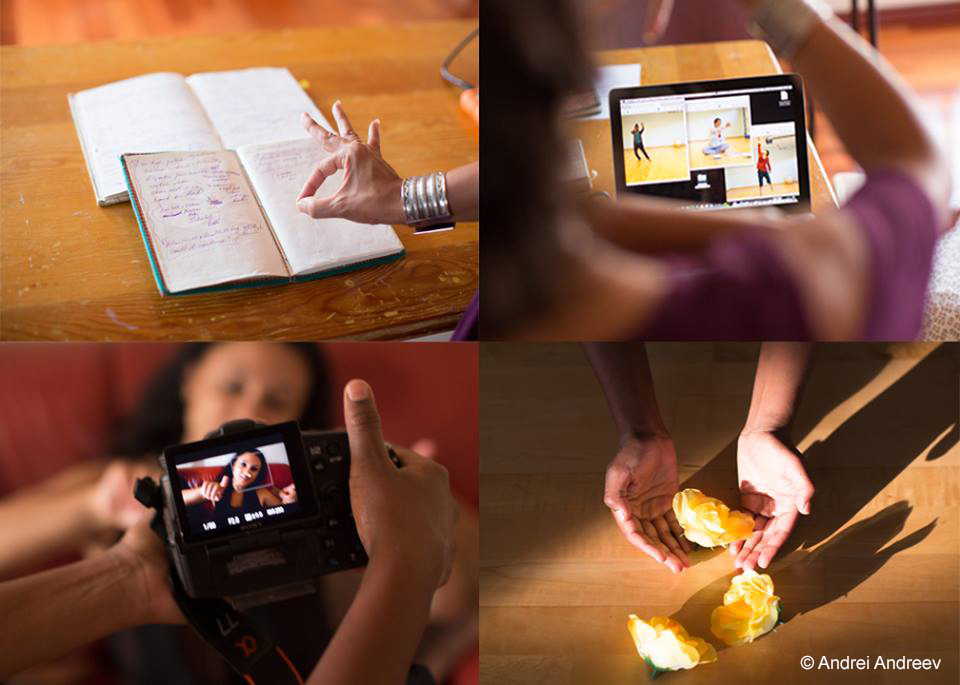The Post Natyam Collective, a transnational, web-based coalition of choreographers and scholars, founded in 2004, has developed and cultivated a unique and highly structured mode of process-oriented long distance collaboration, which we keep honing based on the changing circumstances of our professional and personal lives and Needs.*1 *(1) This process of adjusting our long-distance process, which can be described as a kind of looping is based on reflecting, planning, and evaluating the three major aspects of our process (artistic exploration, scholarly engagement, and organizational structuring) and their intersections in a circular way. Each member’s current artistic and/or scholarly interests and needs, along with experiences and insights gained from previous artistic processes, determine how we plan and adjust new processes. In this article I will first review selected notions and theorizations of collaboration and collective authorship as well as production. Then I will outline the Post Natyam Collective’s model of collaboration through the lens of my practical experience as a founding member*2 *(2) in relation to the reviewed articles. Finally I will describe the ways in which the collective’s collaborative process opens a space for our critical work that engages South Asian dance and aesthetics based on one example of a shared artistic process.
(Re-)Thinking collective action in the arts: A selective literature review
Literature on collaboration and collective action in contexts of artistic production and the reception of art works contributes to a contestation of single authorship and the myth of the individual artist genius (see, among others, Becker 1974; (*2) Cvejić 2005;
(*2) Cvejić 2005; (*10) Marchart 2012;
(*10) Marchart 2012; (*11) Rogoff 2002;
(*11) Rogoff 2002; (*15) Ziemer 2012
(*15) Ziemer 2012 (*20)). In the 1970s, sociologist Howard Becker put forward the concept of “art as collective action,” with which he builds on and simultaneously critiques previous sociological writing on art in its social dimension (Becker 1974: 767).
(*20)). In the 1970s, sociologist Howard Becker put forward the concept of “art as collective action,” with which he builds on and simultaneously critiques previous sociological writing on art in its social dimension (Becker 1974: 767). (*2) Becker talks about art works as well as artistic innovation as cooperations between a number of specialized participants who all contribute to the existence of an art work. He includes everything it takes to produce the artwork into his considerations (beyond the roles that are explicitly considered artistic, including, e.g., those who provide rehearsal space, or publicity to build the audience who experience the work):
(*2) Becker talks about art works as well as artistic innovation as cooperations between a number of specialized participants who all contribute to the existence of an art work. He includes everything it takes to produce the artwork into his considerations (beyond the roles that are explicitly considered artistic, including, e.g., those who provide rehearsal space, or publicity to build the audience who experience the work):
Whatever the artist, so defined, does not do himself must be done by someone else. The artist thus works in the center of a large network of cooperating people, all of whose work is essential to the final outcome. Wherever he depends on others, a cooperative link exists. (ibid.: 769). (*2)
(*2)
While making decisions, for example, about divisions of labor or the terms of the cooperation, according to Becker, collaborators “rely on earlier agreements [that have] now become customary, agreements that have become part of the conventional way of doing things in that art” (ibid.: 770). (*2)*3 *(3) These conventions, which “cover all the decisions that must be made with respect to works produced in a given art world” (ibid.: 770–771)
(*2)*3 *(3) These conventions, which “cover all the decisions that must be made with respect to works produced in a given art world” (ibid.: 770–771) (*2) are discussed by Becker in their facilitating as well as in their restrictive dimensions: while they make establishing cooperations faster and more efficient and are usually standardized but not static (ibid.),
(*2) are discussed by Becker in their facilitating as well as in their restrictive dimensions: while they make establishing cooperations faster and more efficient and are usually standardized but not static (ibid.), (*2) they can also restrict artists, particularly because “they do not exist in isolation, but come in complexly interdependent systems, so that making one small change often requires making changes in a variety of activities” (772).
(*2) they can also restrict artists, particularly because “they do not exist in isolation, but come in complexly interdependent systems, so that making one small change often requires making changes in a variety of activities” (772). (*2) Becker here considers the interconnectedness of aesthetic convention and available infrastructure for the coming into existence and circulation of an artwork (ibid.).
(*2) Becker here considers the interconnectedness of aesthetic convention and available infrastructure for the coming into existence and circulation of an artwork (ibid.). (*2)
(*2)
Sandra Chatterjee ( 2015): Rethinking Collective Artistic Production. In: p/art/icipate – Kultur aktiv gestalten # 06 , https://www.p-art-icipate.net/rethinking-collective-artistic-production/



 Artikel drucken
Artikel drucken